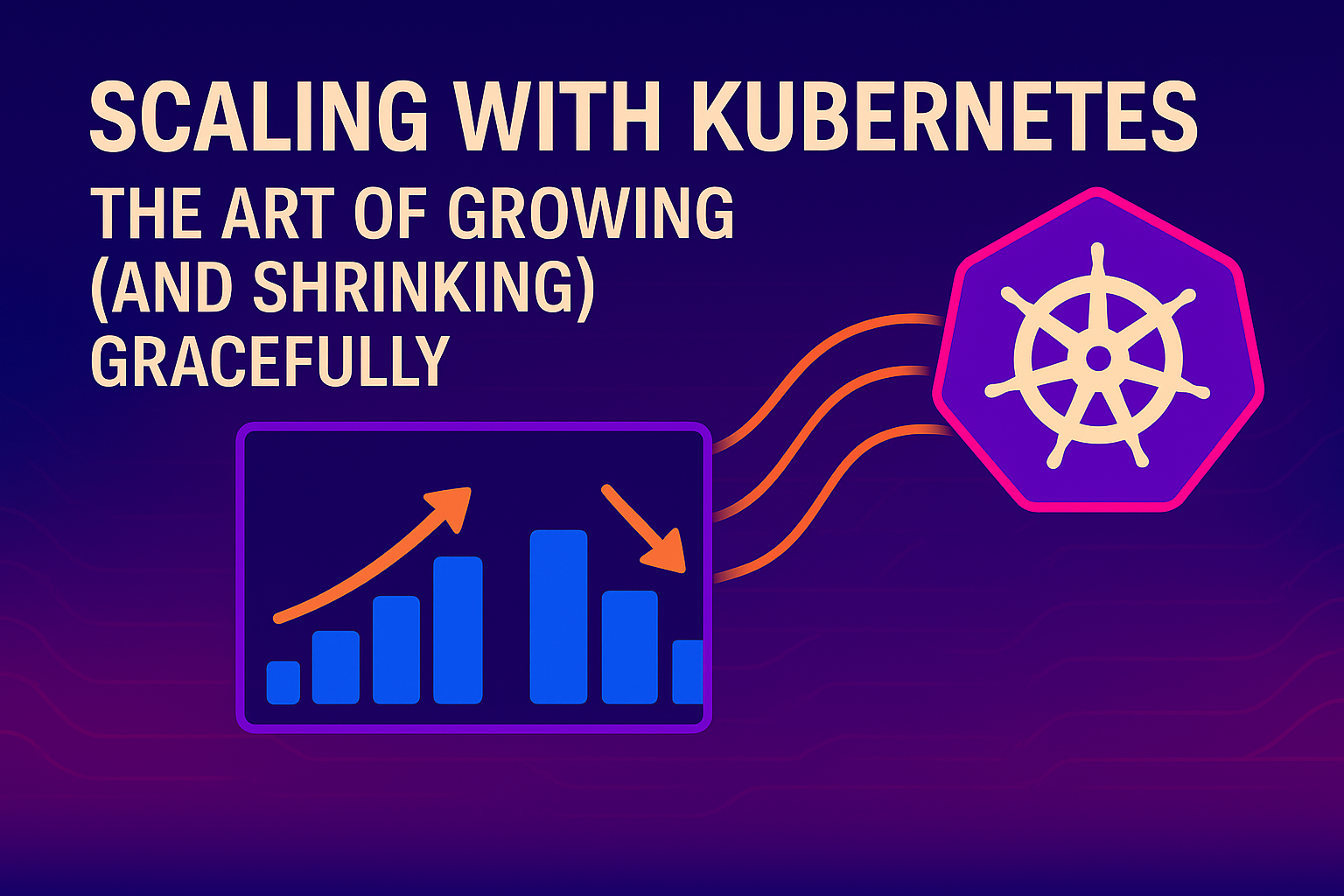Part 6 - Scaling with Kubernetes: The Art of Growing (and Shrinking) Gracefully
Scaling with Kubernetes is like breathing—do it right, and your app stays alive without anyone noticing the effort.

Picture this: It's 3 AM, and your mobile app just got featured on a popular tech blog. Within minutes, your user base explodes from a few hundred daily active users to thousands of simultaneous connections. Your servers are screaming, your database is crying, and somewhere in the distance, you can almost hear the sound of revenue slipping away as frustrated users abandon your overwhelmed application. Sound familiar? Welcome to every developer's scaling nightmare—and Kubernetes' moment to shine.
The beauty of modern container orchestration isn't just that it can handle this chaos; it's that it can do so automatically, intelligently, and often before you even know there's a problem. Today, we're diving deep into how Kubernetes transforms the ancient art of "panic scaling" into an elegant, automated dance of resource management through autoscaling and load balancing.
The Scaling Dilemma: Growing Pains in the Digital Age
Before we explore Kubernetes' scaling superpowers, let's acknowledge the fundamental challenge every application faces: unpredictability. Traffic patterns rarely follow neat, predictable curves. Instead, they resemble the heart rate monitor of someone watching a horror movie—sudden spikes, unexpected valleys, and the occasional flatline that makes you wonder if everything's broken.
Traditional scaling approaches force you into an uncomfortable choice. You can either over-provision resources (paying for capacity you don't use 80% of the time) or under-provision (crossing your fingers that nothing goes viral). It's like trying to decide how much food to prepare for a party when you have no idea if five people will show up or fifty.
Kubernetes fundamentally changes this equation by introducing intelligent, automated scaling mechanisms that respond to real-time demand. Instead of guessing, your infrastructure becomes responsive, growing and shrinking based on actual need rather than anxious predictions.
Horizontal Pod Autoscaling: Your Digital Workforce Manager
The Horizontal Pod Autoscaler (HPA) is perhaps Kubernetes' most elegant solution to the scaling problem. Think of HPA as the world's most efficient HR manager—one who can instantly hire and fire employees based on workload demand, never gets tired, and somehow always makes the right decisions.
How HPA Actually Works
At its core, HPA operates on a simple but powerful principle: monitor resource utilization and adjust the number of running pods accordingly. Every 15 seconds by default, HPA evaluates metrics like CPU utilization, memory consumption, or custom metrics you define, and decides whether your application needs more or fewer instances.
The magic happens in HPA's decision-making algorithm. Rather than making knee-jerk reactions to momentary spikes, HPA considers trends and implements safeguards against "thrashing"—the chaotic situation where pods are constantly being created and destroyed in rapid succession. This prevents the digital equivalent of a hiring manager who fires everyone on Monday and desperately rehires them on Tuesday.
Beyond CPU: The Evolution of Smart Scaling
While early implementations of HPA focused primarily on CPU utilization, modern Kubernetes deployments leverage far more sophisticated metrics. You can scale based on memory usage, network I/O, queue lengths, or even custom application-specific metrics like user session counts or database connection pools.
Recent research has pushed HPA capabilities even further. Advanced implementations like Graph-PHPA use machine learning techniques, employing LSTM-GNN (Long Short-Term Memory Graph Neural Networks) to predict scaling needs before they occur. Similarly, Smart HPA introduces resource-efficient approaches specifically designed for microservice architectures, making scaling decisions based on interconnected service dependencies rather than isolated metrics.
Practical HPA Configuration
Setting up HPA involves defining scaling policies that balance responsiveness with stability. A typical configuration might specify that your application should maintain an average CPU utilization of 70%, with minimum and maximum pod counts to prevent both under-provisioning and runaway scaling.
The beauty of modern HPA implementations lies in their ability to handle multiple metrics simultaneously. If you configure scaling based on both CPU and memory metrics, HPA will choose the scaling recommendation that requires the most resources, ensuring your application remains responsive under various load conditions.
Cluster Autoscaling: Managing the Infrastructure Itself
While HPA handles scaling your applications, Cluster Autoscaler tackles an equally important challenge: ensuring you have enough underlying infrastructure to support those applications. Imagine HPA as a restaurant manager who can instantly hire more waitstaff, while Cluster Autoscaler is the one who can magically expand the restaurant itself when you need more tables.
The Node Scaling Challenge
Cluster Autoscaler monitors your cluster for pods that cannot be scheduled due to insufficient resources—a condition known as "pending" or "unschedulable" pods. When it detects this situation, it automatically provisions new nodes to accommodate the workload. Conversely, when nodes remain underutilized for extended periods, Cluster Autoscaler removes them to optimize costs.
This process operates on a per-node-pool basis, allowing for sophisticated resource management strategies. Different workloads might require different types of compute resources—CPU-intensive applications might need compute-optimized instances, while memory-heavy workloads require memory-optimized nodes. Cluster Autoscaler can manage multiple node pools simultaneously, each optimized for specific workload characteristics.
Cost Optimization Through Intelligent Scaling
One of Cluster Autoscaler's most valuable features is its cost-awareness. When multiple node pool options could satisfy scaling requirements, it attempts to choose the most cost-effective option, factoring in considerations like Spot instances and regional pricing differences. This transforms infrastructure scaling from a purely performance-focused decision into a balanced optimization of performance and cost.
Load Balancing: The Traffic Director
Scaling isn't just about having more resources; it's about effectively utilizing those resources. Kubernetes' built-in load balancing mechanisms ensure that traffic is distributed optimally across your scaled infrastructure.
Internal Load Balancing: Keeping Traffic Flowing
Within your Kubernetes cluster, Services provide automatic load balancing across pods. The default round-robin algorithm ensures that requests are distributed evenly across available instances, but more sophisticated algorithms can accommodate different application architectures and performance characteristics.
For microservice architectures, effective load balancing becomes crucial for maintaining system stability. When services scale independently, load balancers must adapt to changing topologies, routing traffic to healthy instances while avoiding overloaded or failing components.
External Load Balancing: Managing the Outside World
Kubernetes provides multiple approaches for external load balancing, from simple NodePort configurations to sophisticated Ingress controllers. LoadBalancer services integrate with cloud provider load balancers, automatically configuring external traffic distribution as your applications scale.
Modern implementations often combine multiple load balancing strategies. An Ingress controller might handle SSL termination and path-based routing, while underlying Services manage traffic distribution across scaled pod replicas.
Advanced Scaling Strategies: Beyond the Basics
As Kubernetes scaling has matured, several advanced approaches have emerged that push beyond traditional reactive scaling models.
Proactive and Predictive Scaling
Traditional autoscaling is inherently reactive—it responds to load after it occurs. However, cutting-edge implementations are moving toward proactive scaling that anticipates demand before it materializes. The Proactive Pod Autoscaler (PPA) uses historical data and trend analysis to scale applications preemptively, reducing response times during load spikes.
These predictive approaches are particularly valuable for applications with known traffic patterns—e-commerce sites that expect Black Friday surges, media platforms anticipating viral content, or financial applications that scale before market opening.
Requirements-Driven Autoscaling
Recent developments in autoscaling focus on meeting specific Service Level Objectives (SLOs) rather than simple resource thresholds. The MS-RA (Microservice Requirements-driven Autoscaler) framework uses MAPE-K self-adaptive loops to ensure applications meet performance requirements while minimizing resource consumption.
This approach represents a fundamental shift from resource-centric scaling to outcome-centric scaling, where the goal isn't just efficient resource utilization but guaranteed application performance.
Multi-Cloud and Edge Scaling
As applications increasingly span multiple cloud providers and edge locations, scaling strategies must account for geographic distribution and network latency. Advanced autoscaling implementations consider not just resource availability but also data locality, network costs, and regulatory requirements when making scaling decisions.
Real-World Scaling Success Stories
The theoretical benefits of Kubernetes autoscaling become compelling when examining real-world implementations. Alibaba Cloud's AHPA (Adaptive Horizontal Pod Autoscaling) system demonstrates how AI-driven scaling algorithms can significantly outperform traditional rule-based approaches, achieving substantial resource savings while maintaining application performance.
Similarly, organizations implementing Smart HPA in microservice environments report dramatic improvements in resource efficiency. By considering service interdependencies rather than scaling services in isolation, these implementations achieve better overall system performance with fewer resources.
Building Your Scaling Strategy
Implementing effective autoscaling requires more than just enabling HPA and Cluster Autoscaler. Successful scaling strategies involve careful consideration of application architecture, traffic patterns, and business requirements.
Start by understanding your application's scaling characteristics. CPU-bound applications scale differently than memory-intensive ones, and stateful services have different requirements than stateless microservices. Design your scaling policies to match your specific workload patterns rather than applying one-size-fits-all configurations.
Consider implementing multiple scaling dimensions simultaneously. Horizontal scaling (adding more instances) often works best in combination with cluster scaling (adding more nodes) and even vertical scaling (increasing individual container resources) for optimal resource utilization.
Monitor and tune your scaling policies continuously. The initial configuration is just the starting point; effective autoscaling requires ongoing observation and adjustment based on real-world performance data.
The Future of Intelligent Infrastructure
Kubernetes autoscaling represents more than just automated resource management—it embodies a fundamental shift toward intelligent infrastructure that adapts to changing requirements without human intervention. As applications become more complex and traffic patterns more unpredictable, this adaptability becomes not just convenient but essential.
The next evolution in scaling is already emerging, with AI-driven approaches that learn from application behavior, predict scaling needs, and optimize for multiple objectives simultaneously. These systems promise to transform infrastructure management from a reactive discipline into a proactive, intelligent capability that anticipates and prepares for changing demands.
Your applications deserve infrastructure that grows and shrinks as gracefully as they do. With Kubernetes autoscaling, you're not just managing containers—you're conducting an orchestra where every instrument knows exactly when to join in and when to step back, creating a symphony of performance that responds flawlessly to whatever your users throw at it.
So the next time you're lying awake at 3 AM, remember: with properly configured Kubernetes autoscaling, the only reason you should be losing sleep is if you're dreaming about all the things you can build when infrastructure management becomes this effortless.

